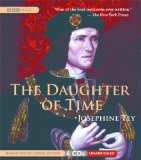
 The Daughter of Time
The Daughter of TimeReviewed December 29, 2010.
BBC Audiobooks America, 2002. Book originally written in 1951.
Complete and Unabridged. 6 compact discs, 5 hours, 19 minutes.
Starred Review
Sonderbooks Stand-out 2010: #2 Fiction
I read about this book in a list of Ten Classic Mysteries. (I think it was a posting by Booklist.) Later, it came up with my son, and he said that he had really liked it a lot. He said this rather defensively, and it turned out that it had been assigned reading in his 10th grade English class, covering World Literature. They had also studied the Shakespeare play Richard III. It turned out that not everyone in his class liked it, but the fact that Tim did was recommendation enough for me.
I listened to the audiobook version, with an absolutely brilliant narrator. (His American accent wasn't great, but that was only one character. Everything else was superb.) The amazing thing is that in this book there is absolutely no action. The main character is lying in a hospital bed staring at the ceiling. Yet the book was so engrossing, I hated to get out of the car when I reached my destination, and kept thinking about the story all day.
Alan Grant, Scotland Yard inspector, had an accident while on duty that has put him in a hospital bed. People are bringing him annoyingly cheerful popular books to read, and he's not interested. So when a friend, knowing his interest in faces, brings in several portraits of historical figures who have mysteries associated with them, he is intrigued in spite of himself.
The face that he can't stop thinking about is the portrait of Richard III. Yet there was no mystery associated with him, was there? He was the embodiment of the wicked uncle -- having his two nephews in the tower killed. Doesn't everyone know that? Yet, before he knew whose face that was, why did Grant think it was the face of a judge? He usually wasn't so far wrong about people's faces.
Grant begins investigating -- getting some books about Richard III and then some primary sources and the help of an American researcher. He draws a very different conclusion about the murderer of the princes in the tower -- and builds an extremely convincing case. (Assuming that all the sources he refers to are actually as described -- and I see no reason to think they wouldn't be.)
I love it that Josephine Tey wrote this as a detective story featuring her own detective. As a book of history, it would probably get dry and boring, and I'd never pick it up -- as a detective story, you share with the detective the thrill of discovering the truth. And the writing had me on the edge of my seat. It's the sort of book, if I hadn't been listening to it in the car, I'm sure I would have read in one sitting. Yet how she pulled that off with her detective flat in bed, is beyond me!
Absolutely brilliant!
The title is from this quotation by Francis Bacon: "Truth is the daughter of time, not of authority." There is much exploration in the book of how "history" is made.
